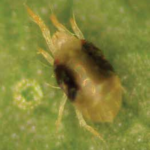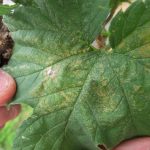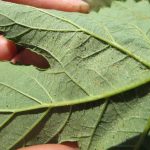
As we are approaching the hottest time of year, with temperatures projected for the 90’s midweek, it is a great time to remind you to be on the lookout for two spotted spider mites. These tiny cousins of spiders also produce webbing, though spider mites use it to protect themselves (from the elements, natural enemies or pesticides), not to catch prey. Spider mite damage occurs when they jam their mouthparts into, and then sucking the life out of, your hops.

At this point of the season, spider mite feeding causes a characteristic stippling of leaves which, at low to moderate levels, doesn’t cause economic injury since there is no apparent effect on yield or quality later in the season. Heavy infestation of two spotted spider mites can lead to reduced photosynthesis or even defoliation. This has led to the economic thresholds in the Pacific Northwest ranging from an average of 5-10 mites per leaf in mid to late July. In other parts of the world, thresholds of up to 60 mites per leaf are used.

Hot, dry, dusty conditions, those typical of August, tend to favor rapid two spotted spider mite population growth. Unfortunately, August is also when hop cones are maturing. If spider mites make their way into cones there can be a decrease in quality, and severe spider mite infestations can cause hop cones to become brittle and shatter. So monitoring two spotted spider mites from now until harvest is crucial to ensure mite infestations don’t get out of control.
It is important to recognize that pesticide applications, particularly broad-spectrum insecticides and repeated application of sulfur, can actually exacerbate the problem. Following an insecticide application, spider mite populations are generally quick to rebound, much quicker than natural enemies like spider mite destroyers. This allows spider mites to reinfest your yard without any natural control. Whereas using selective miticides can enhance biological control.
For additional information on two spotted spider mites and much, much more, check out the newly updated Field Guide for Integrated Pest Management in Hops. And of course, keep calm and hop on…
